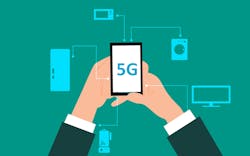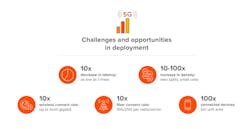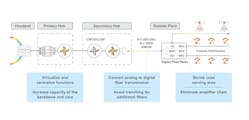The launch of 5G wireless networks is both an opportunity and a challenge for cable’s hybrid fiber/coax (HFC) networks. In the UK, the proposed merger of Telefónica's mobile carrier O2 with Liberty Global’s Virgin Media will bring together millions of wireless and broadband subscribers and a combined network infrastructure to support both. In addition, many cable multiple-systems operators (MSOs) offer wireless services to their subscribers today as mobile virtual network operators (MVNOs) – essentially a rebranded wireless service from physical wireless network operators. In Q1 2020, Comcast added 216,000 new wireless lines, bringing its total to 2.3 million.
Utilizing a combination of shared radio frequency (RF) spectrum and acquisition of licensed spectrum in upcoming RF auctions, cable MSOs have a meaningful opportunity to launch their own physical 5G networks. Doing so would enable their wireless subscribers to remain on their own networks and reduce MVNO costs. As an example, both Charter and Comcast are planning to bid in an upcoming FCC CBRS (3.5 GHz Citizens Broadband Radio Service) frequency band auction.
With an anticipated tenfold increase in the number of 5G cell sites to be deployed, cable also has an opportunity for incremental revenue by offering wholesale mobile transport services for third-party wireless networks. But 5G mobile transport has its challenges, as visible in Figure 1. With increased wireless spectrum, enhanced modulation techniques, and sophisticated antennas, 5G radios can require up to 10 Gbps or 25 Gbps connectivity per sector. In addition, synchronization and timing are critical for 5G operation to support multi-radio coordination and time-division duplex (TDD) operation, where a single RF carrier is utilized for both transmit and receive between the radio and the end device or smartphone.
Enter DAA and CIN
Cable’s Distributed Access Architecture (DAA) and Converged Interconnect Network (CIN) are two common industry terms used to describe the transformations underway with today’s HFC networks. While they are related, DAA generally refers to pulling fiber closer to subscribers (fiber deep), reducing the number of homes served by each coax network segment, and distributing part of the DOCSIS coax functionality deeper into the network – generally at the fiber node – to increase bandwidth per subscriber with a goal of achieving 10G (i.e., 10 Gbps) connectivity.
The definition of CIN has evolved with time. While CIN was originally focused on high-speed data (and voice) as well as video delivery between the Converged Cable Access Platform (CCAP) core and the fiber node, it takes on a much broader services context today that includes a unified network architecture to support existing services as well as new ones, including 5G mobile transport. In general, CIN reflects a broader network services and architectural framework than DAA and includes activities like network function virtualization and distributed computing and routing.
One of the most impactful architectural shifts with DAA/CIN evolution is the change from analog to digital optical transmission between the hub and fiber node, as identified in Figure 2. In the existing network, digital signals are modulated and carried over fiber on analog waveforms. The primary role of the fiber node is to convert the analog optical signals to electrical for coaxial transmission. But with DAA/CIN evolution, we replace the analog fiber transmission in the outside plant with digital optical transmission (like in other parts of the network) and only launch the analog waveforms at the fiber node over the coax.
How Does This Help 5G?
By locating the unique analog aspects of coaxial transmission deeper in the network – to the digital fiber node – cable operators are creating a digital demarcation point in the outside plant. The digital fiber node can then be modularized to support incremental services beyond 10G high-speed internet connectivity and video services – including 5G mobile transport.
So, where are we at on this transformational journey? According to Omdia’s 2020-2025 Cable Broadband Access Equipment Forecast, only about 6% of global cable broadband access equipment in 2019 was for the DAA transition. Following another flat DAA investment year in 2020, Omdia predicts that 34% of equipment sales will support the DAA transition by 2025. At this pace, cable operators run the risk of throttling their own 5G mobile network deployments or missing early opportunities to provide wholesale 5G mobile transport services.
Let’s Go Faster
While the transition to digital optics and a digital fiber node has not achieved mass commercial deployment, what have we learned from early trials and deployments, and how might we apply these learnings to accelerate this transition? We believe at least part of the answer lies in automating, innovating, and disaggregating.
Automating Installations
First, we must address the real operational effects from changes in the DAA network. A digital optical fiber node can provide optical-to-coaxial conversion for multiple neighborhoods or serving areas, with each serving area fed by ~10G connectivity from the hub site. Since the fiber node will often only be fed by a single fiber pair, we must either utilize multiple 10-Gbps optical wavelength-division multiplexed (WDM) signals (one per coax serving area) or multiplex/demultiplex multiple 10G signals into a higher-capacity 100G/200G signal for transmission to/from the fiber node. Multiplexing/demultiplexing can add more cost and complexity to the network because it requires the installation of an electrical switch or transponder at each end of the fiber to transmit/receive the converged 100G/200G signal and break it into individual 10G streams on the other end.
Alternatively, if we utilize 10-Gbps DWDM pluggable optics, we either have to program the optic for the right wavelength every time we do an installation or we need to provide outside plant personnel with a collection of fixed-wavelength pluggable optics – one per DWDM wavelength utilized. We are left with the choice of either increased capex or opex, or both.
Fortunately, there is a better way. With auto-tunable 10G and 25G DWDM pluggable optics, cable operators can deliver N x 10-Gbps/25-Gbps wavelengths to the fiber node while minimizing capital and operational costs. Auto-tunable optics utilize a passive filter to let a single wavelength pass, and a patented two-way handshaking algorithm embedded in the pluggable optic to auto-negotiate and lock onto the correct wavelength within 1 to 3 minutes.
Outside plant personnel can utilize a single 10G/25G SFP+ pluggable optic to deliver DWDM support for up to 80 wavelengths per fiber node, with each wavelength able to support a different service, including 5G mobile transport. Gone is the need to carry a host of fixed-wavelength pluggable optics (one per wavelength) or to program the pluggable optic during every new installation and coordinate with headend personnel to ensure far-end reception. The same 10G or 25G pluggable optic that is utilized for connecting residential coax segments can also provide 10G or 25G optical connectivity for subtending 5G radios. Auto-tunable DWDM pluggable optics are a great way for cable operators to reduce capex, shorten installation times, and eliminate configuration errors.
Innovating Beyond DAA
Beyond auto-tunable optics, point-to-multipoint optics will be the next major inflection in optical transceiver technologies. Such optics utilize digital signal processing (DSP) to subdivide the transmission and reception of a given wavelength (and laser) into a series of smaller frequency channels called “digital subcarriers.” These digital subcarriers can be independently modulated, managed, and assigned to different destinations, enabling the industry’s first scalable point-to-multipoint, direct low-speed to high-speed optical transceiver connectivity.
A single 400G point-to-multipoint optics hub module generates 16 x 25-Gbps digital subcarriers. One or multiple digital subcarriers can be assigned to a specific destination to provide the required bandwidth. Point-to-multipoint optics transceivers are designed to be installed into a wide range of networking equipment, including Ethernet switches, routers, and radio access equipment. Such optics can provide connectivity up to 1,000 km and are targeted for industry-standard pluggable form factors like QSFP-28, CFP2-DCO, and QSFP-DD. With point-to-multipoint optics, one can envision installing a 400G transceiver at a hub site or headend location to optically express traffic in 25G assignable increments all the way to multiple digital fiber nodes – bypassing or eliminating intermediate routers/switches. Utilizing the fiber node as a modular outdoor demarcation point, one can envision assigning a subcarrier to each of the multiple subtending coax segments while assigning additional subcarriers for other services like 5G radio transport.
By reducing the number of optical transceivers in the network and simplifying or eliminating intermediate aggregation, economic modeling of point-to-multipoint optics on real-world networks has demonstrated multi-year total cost of ownership (capex and opex) savings in excess of 70%. Eliminating intermediate electrical aggregation and switching also reduces latency and packet delay variation that can affect timing and synchronization, which is critical for 5G services.
While still under development, with anticipated delivery in 2021, point-to-multipoint optics offer the potential to help cable operators simplify their networks and better utilize their capital to accelerate the pace of cable network transformation and deliver incremental services like 5G mobile transport.
Disaggregated Routing
With networks evolving and fiber nodes taking on a more prominent role in the cable network as multi-service optical demarcation points for a host of services including 5G mobile transport, cable operators are having a difficult time modeling future traffic demand. With a multi-slot chassis-based solution, there is always fear of buying too much capacity and stranding precious working capital or buying too little and affecting service delivery.
That is part of the reason for the movement toward disaggregated routing solutions, where a family of pizza-box routing/switching elements can be deployed like Lego bricks in configurations that include standalone, multi-unit stacked, or horizontally scalable router configurations with a virtual backplane. In addition, some vendors are enabling their routing software to run on a broad range of merchant silicon and hardware, including that from white-box suppliers. With open disaggregated routing, cable operators increase their flexibility and future hardware options while better aligning network infrastructure costs to real capacity demands.
Conclusion
To date, cable’s DAA/CIN transformation to provide a path to 10G connectivity and support for multiple services, including 5G wireless transport, has not progressed widely. However, by automating and simplifying operations with auto-tunable optics, further simplifying and cost-reducing the network with innovative point-to-multipoint optics, and reimagining network routing with open and disaggregated solutions to better align networking costs to capacity demands, cable operators may just find that they can accelerate their network transformation. As a result, they can support the launch of their own 5G wireless networks and deliver incremental revenue with wholesale mobile transport for others.
Tim Doiron is senior director, solution marketing, at Infinera.







